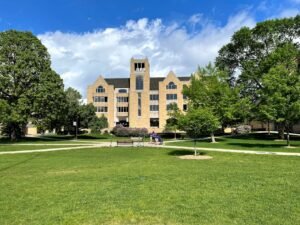- University of Santo Tomas (UST)
Overview, Fees, Life in institution & the place, Syllabus, Benefits
About University of Santo Tomas (UST)
 The University of Santo Tomas (UST), founded on April 28, 1611, by Spanish friar Miguel de Benavides, holds the distinction of being the oldest existing university in Asia. Allow me to take you on a journey through its rich past. UST owes its existence to the visionary initiative of Bishop Miguel de Benavides, O.P., who served as the third Archbishop of Manila. On July 24, 1605, Bishop de Benavides bequeathed a sum of one thousand five hundred pesos (a significant amount at the time) and his personal library. These funds and his collection of books formed the nucleus for the establishment of UST and its library. The founding of UST officially took place on April 28, 1611.
The University of Santo Tomas (UST), founded on April 28, 1611, by Spanish friar Miguel de Benavides, holds the distinction of being the oldest existing university in Asia. Allow me to take you on a journey through its rich past. UST owes its existence to the visionary initiative of Bishop Miguel de Benavides, O.P., who served as the third Archbishop of Manila. On July 24, 1605, Bishop de Benavides bequeathed a sum of one thousand five hundred pesos (a significant amount at the time) and his personal library. These funds and his collection of books formed the nucleus for the establishment of UST and its library. The founding of UST officially took place on April 28, 1611.
The original campus was situated within the Intramuros, the Walled City of Manila. Initially called the Colegio de Nuestra Señora del Santísimo Rosario, it was later renamed Colegio de Santo Tomas in honor of the foremost Dominican theologian, St. Thomas Aquinas. On July 29, 1619, the Colegio received authorization to confer academic degrees in theology and philosophy.
By November 20, 1645, Pope Innocent X elevated the college to the status of a university. In 1680, it came under the royal patronage of the Spanish monarchy. Pope Innocent XI declared it a Public University of General Studies in 1681, allowing it to confer other degrees. In 1734, Pope Clement XII authorized UST to confer degrees in all existing faculties and any future ones.
The expulsion of the Society of Jesus from the Philippines in 1768 left UST as the sole institution of higher learning in the islands. It played a crucial role in education during this period.
On May 20, 1865, a royal order from Queen Isabella II granted UST the power to direct and supervise all schools in the Philippines. In 1902, Pope Leo XIII bestowed upon UST the title of “Pontifical University”. By 1947, Pope Pius XII honored it with the title of “The Catholic University of the Philippines”. UST became the second university in the world, after the Gregorian University in Rome, to be formally recognized as a Pontifical University.
Due to increasing enrollment, UST moved its campus from Intramuros to its present site in the Sampaloc district in 1927. The current campus spans a total of 21.5 hectares.
UST has produced national heroes, church martyrs, renowned scientists, national artists, business leaders, athletes, prominent doctors, four Philippine presidents, three vice presidents, and six Chief Justices. Its commitment to superior academic programs remains unwavering.
Faculty and Student Population:
- UST’s faculty comprises 2,164 members from various disciplines and specialties.
- The student population, across all levels, typically hovers around 33,407 during the second term of 2023-2024.
- Notably, UST attracts 800 foreign medical students, drawn by its unique geographic location and conducive learning environment.
Vision & Mission:
- Vision: UST envisions healthy communities enjoying a quality life.
- Mission: Inspired by community orientation, UST commits to providing humane and integral health sciences education and services, emphasizing primary health care, research, patient care, and community engagement.
Overview - University of Santo Tomas (UST)
| Total Course Fees | $18000 Approx |
| University Ranking | Country Rank: 5 World Rank: 1964 |
| Course Duration | 5 years (academic program) + 1-year internship |
| Medium of Instruction | English |
| Recognition & Accreditation | World Health Organization (WHO) National Medical Commission (NMC) United Nations Educational, Scientific and Cultural Organization (UNESCO) |
| Location | Manila, Metro Manila, Philippines |
Fee Structure of University of Santo Tomas (UST)
Manila City from Indian student's perspective
Culture:
Language: Filipino (Tagalog) and English are the primary languages spoken in Metro Manila. English is widely used in education and business, making it easier for Indian students to communicate and adapt.
Religion: Roman Catholicism is the predominant religion, but there are also various other Christian denominations and a growing number of other faith communities.
Hospitality: Filipinos are known for their warm hospitality and friendliness, making Metro Manila a welcoming environment for international students.
Arts and Entertainment: Metro Manila has a vibrant cultural scene with numerous theaters, galleries, and concert halls. The city hosts various festivals and events showcasing traditional and contemporary Filipino arts and culture.
Education: Metro Manila is home to several prestigious universities and educational institutions, attracting students from around the world, including India.
Food:
Traditional Cuisine: Filipino cuisine features dishes like Adobo (marinated meat stew), Sinigang (sour soup), and Lechon (roast pig).
Influence of Other Cuisines: Due to its diverse population, Metro Manila offers a variety of cuisines, including Chinese, Japanese, Korean, and Western dishes.
International Options: Indian students can find restaurants offering Indian cuisine, along with other international food options.
Street Food: The city’s streets are lined with food stalls selling local snacks like balut (fertilized duck egg), kwek-kwek (battered quail eggs), and taho (sweet tofu dessert).
Lifestyle and Other Relevant Information:
Climate: Metro Manila has a tropical climate with a wet season (June to November) and a dry season (December to May). Indian students may find the weather similar to certain parts of India.
Transportation: Public transportation includes jeepneys, buses, and the MRT/LRT train systems. Taxis and ride-sharing services are also readily available.
Cost of Living: The cost of living in Metro Manila is relatively affordable compared to major cities in other countries, making it a budget-friendly option for students.
Recreation: Metro Manila offers various recreational activities, including visiting historical sites, shopping malls, parks, and enjoying the nightlife in bars and clubs.
Safety: Metro Manila is generally safe for residents and visitors, but like any major city, it is essential to take common-sense precautions.
Why Study MBBS at University of Santo Tomas (UST)?
Legacy and Reputation:
- UST, founded in 1611, is one of the oldest and most prestigious universities in Asia.
- Its Faculty of Medicine and Surgery has a rich history of producing competent and compassionate medical professionals.
- The university consistently ranks among the top 1000 universities globally.
English-Medium Education:
- UST offers MBBS education in English, making it accessible to international students.
- Language barriers are minimized, ensuring effective communication during lectures, clinical training, and interactions.
Quality Infrastructure and Facilities:
- UST provides a well-equipped infrastructure for medical education.
- Modern classrooms, laboratories, and simulation centers enhance the learning experience.
- Students benefit from cutting-edge educational equipment.
Multicultural Environment:
- UST’s diverse student body creates a multicultural environment.
- Interacting with peers from different countries enriches cultural understanding and broadens perspectives.
Clinical Exposure:
- After the second year, UST MBBS students gain hands-on experience by practicing at public hospitals.
- Clinical rotations allow students to apply theoretical knowledge in real healthcare settings.
Global Recognition and Accreditation:
- UST’s MBBS program is acknowledged by reputable bodies:
- National Medical Commission (NMC)
- United Nations Educational, Scientific and Cultural Organization (UNESCO)
- World Health Organization (WHO)
- Ministry of Science and Education of the Republic of Kazakhstan
Faculty Excellence:
- UST’s faculty members are highly qualified and dedicated.
- Students receive individual attention and mentorship throughout their MBBS journey.
No Entrance Exam:
- UST does not require an entrance exam for MBBS admission.
- Aspiring medical students can focus on their academic preparation without additional stress.
Scholarship Opportunities:
- UST supports deserving candidates through scholarship programs.
- Financial assistance ensures that talented students can pursue their medical education.
Culinary Comfort:
- Indian students studying at UST can enjoy familiar cuisine, including Indian food.
- Comfort in daily meals contributes to a positive learning experience.
Global Collaborations:
- UST maintains strong ties with institutions worldwide.
- Joint projects and exchange programs with universities in Russia, the USA, Europe, and Asia enhance exposure and networking.
Holistic Development:
- UST encourages students to actively participate in extracurricular activities.
- Whether regional, national, or international, these activities foster personal growth and well-rounded development.
MBBS Course Duration
The MBBS program at the University of Santo Tomas follows a structured timeline:
Basic Medical Education:
- The core MBBS program lasts for five years.
- During this period, students acquire a strong foundation in both theoretical knowledge and practical skills related to medicine.
- They engage in rigorous coursework, clinical rotations, and hands-on training.
Internship:
- After completing the five years of MBBS courses, students are required to undergo a one-year mandatory internship.
- This internship takes place under the supervision of licensed doctors in affiliated hospitals.
- It provides invaluable clinical experience and prepares students for their future medical practice.
In summary, the total duration for the MBBS program at UST is five years of academic study plus one year of internship, making it a comprehensive and well-structured pathway toward becoming competent medical professionals.
Life in the Philippines from Indian students' perspective
Welcoming and Hospitable Culture
Warm Hospitality: The Filipino people are renowned for their warmth, friendliness, and hospitality. As an international student, you’ll find a welcoming environment where locals are eager to engage with foreigners.
Inclusive Atmosphere: The Philippines embraces diversity, making it easy for students from different backgrounds to adapt. You’ll feel included and part of a larger community.
Education System and Affordability
Quality Education: The Philippines has a well-established education system with several universities and colleges offering a wide range of programs. Many institutions provide English-medium education, which is advantageous for international students.
Affordable Tuition: Compared to other study abroad destinations, the Philippines offers affordable tuition fees. Indian students can pursue their academic aspirations without the burden of excessive costs.
Modern Amenities and Infrastructure
Urban Centers: Major cities like Manila, Cebu, and Davao offer modern infrastructure, including reliable transportation systems, internet connectivity, and amenities. You’ll find convenience and comfort in these urban centers.
Cultural Richness and Festivals
Cultural Diversity: The Philippines is a melting pot of cultures, traditions, and languages. Indian students can immerse themselves in a vibrant cultural scene, attending festivals, exploring local markets, and participating in traditional celebrations.
Festivals: From the colorful Sinulog Festival in Cebu to the lively Ati-Atihan Festival in Kalibo, there’s always something exciting happening. These festivals provide a glimpse into Filipino customs and folklore.
Safety and Security
Safe Environment: The Philippines is generally safe for residents and international students. While it’s essential to exercise caution, you can focus on your studies without major concerns about personal safety.
Natural Beauty and Outdoor Activities
Breathtaking Landscapes: The Philippines boasts stunning natural beauty, including pristine beaches, lush rainforests, and picturesque mountains. Indian students can explore places like Palawan, Banaue Rice Terraces, and Chocolate Hills.
Outdoor Adventures: Whether it’s snorkeling in crystal-clear waters, hiking to waterfalls, or surfing in Siargao, there’s no shortage of outdoor activities. The Philippines is an adventurer’s paradise.
Career Prospects and Networking
Growing Economy: The Philippines’ growing economy presents career opportunities for graduates. You can find internships, part-time jobs, and build a professional network during your studies.
In summary, life in the Philippines offers a blend of cultural richness, affordability, safety, and natural wonders. As an Indian student, you’ll discover a second home where you can thrive academically and personally.
Eligibility Criteria
Indian students applying for MBBS admissions in the Philippines must fulfill the following eligibility criteria:
- Academic Qualifications: Minimum 50% score in Physics, Chemistry, and Biology in Class 12 and passing marks in English. For reserved categories (SC/ST/OBC), a minimum of 40% in these subjects is required.
- Age Requirement: Attained the age of 17 as of 31st December in the admission year.
- NEET Exam: Cleared NEET exam with a minimum of 50th percentile for general/EWS category and 40th percentile for SC/ST/OBC category.
- NMAT Exam: Students must also clear the National Medical Admission Test (NMAT) as part of the admission process.
These criteria ensure that students are well-prepared and eligible to pursue their medical education in the Philippines.
Required Documents for MBBS Admission
- Passport
- Candidate's Recent Photographs
- Class 10 & 12 Marksheet
- NEET Scorecard
- Bank Statement
- PAN
- AADHAR
- Guardian's Declaration
- Covid Vaccination Certificate
- HBS Medical Certificate
Benefits of MBBS in the Philippines
Globally Recognized Degree: Medical degrees from the Philippines are recognized worldwide, including by the WHO, FAIMER, ECFMG, and the National Medical Commission (NMC) of India, allowing graduates to practice medicine globally.
Affordable Education: The Philippines offers affordable tuition fees for MBBS programs compared to many Western countries, making it a cost-effective option for Indian students.
Quality of Education: Medical universities in the Philippines provide high-quality education with a strong emphasis on practical skills alongside theoretical knowledge.
English Medium Instruction: Most medical universities in the Philippines offer programs in English, which is beneficial for Indian students as it eliminates the language barrier and makes it easier to adapt and learn.
Cultural Experience: Studying in the Philippines allows students to experience a new culture and lifestyle, broadening their horizons and contributing to personal growth.
Research Opportunities: The Philippines’ focus on scientific research provides students with opportunities to engage in innovative medical research projects.
Clinical Exposure: Medical students in the Philippines receive extensive clinical training, with opportunities to practice in well-equipped hospitals.
Scholarship Opportunities: Various scholarship programs are available for international students, which can further reduce the financial burden of studying abroad.
Safety and Living: The Philippines is known for its safe environment and offers a comfortable living experience for students, with a relatively low cost of living.
These benefits make the Philippines an attractive destination for Indian students to pursue an MBBS degree, combining quality education with affordability and international recognition.
MBBS Syllabus:
BS 1st session
- General Biology
- General Chemistry
- Organic Chemistry
- Physics
- Mathematics
- English
- Filipino
- Physical Education
BS 2nd session
- Human Anatomy and Physiology
- Biochemistry
- Microbiology
- Psychology
- Sociology
- Research
- Methodology
- Physical Education
MD 1st year
- Gross Anatomy
- Histology
- Biochemistry
- Physiology
- Neuroanatomy
- Preventive Medicine and Community Health
- Medical Ethics
MD 2nd year
- Pathology
- Pharmacology
- Microbiology and Parasitology
- Clinical Pathology
- Medicine I (Introduction to Clinical Medicine)
- Surgery I (Introduction to Surgery)
- Obstetrics
- Pediatrics
MD 3rd year
- Medicine II (Advanced Clinical Medicine)
- Surgery II (Advanced Surgery)
- Obstetrics and Gynecology
- Pediatrics II
- Radiology
- Ophthalmology
- Otorhinolaryngology
- Legal Medicine
- Psychiatry
MD 4th year
- Clinical Clerkship (Rotations in various departments such as Internal Medicine, Surgery, Pediatrics, Obstetrics and Gynecology, Psychiatry, Ophthalmology, Otorhinolaryngology, Radiology, and Community Medicine)
Internship
One-year mandatory internship in affiliated hospitals under the supervision of licensed doctors
FAQ
MBBS abroad is a better options then private medical in India, especially in terms of cost, private medical in India costs a fortune more then that of many countries abroad.
Expertise: Rare Education have years of experience and in-depth knowledge about the admission process, eligibility criteria, fees, and other requirements for pursuing MBBS abroad. We can guide you through the entire process and help you avoid common mistakes and pitfalls.
Time-saving: The admission process for MBBS abroad can be complex and time-consuming. Working with Rare Education can help save a significant amount of time as we can handle all the paperwork and follow-up for you.
Access to information: Rare Education have access to a wide range of information about various medical schools, their fees, and programs. We can help you compare and choose the best options based on your needs and budget.
Professional guidance: Rare Education can provide professional guidance on the best country and medical school to choose based on your academic background, personal interests, and career goals. We can also help you with the visa process, travel arrangements, and settling into your new surroundings.
Support throughout the Process: Rare Education provide ongoing support throughout the entire admission process and beyond. We can answer any questions you have, provide updates on your application status, and help resolve any issues that may arise.
Working with Rare Education for MBBS abroad admission can provide numerous benefits, including expertise, time-saving, access to information, professional guidance, and support throughout the process.
Comparing FMG exam with NEET, we can safely say it is not at all a tough exam. Although there are no specific matrix to judge how tough an exam is, but considering the passing ratio of FMG exam which is roughly 20-25% to that of the percentage of candidates who get selected for government medical college through NEET which is roughly 0.02%, FMG exam is definitely a tough exam in the field of medical studies.

